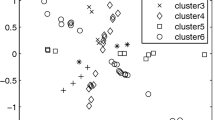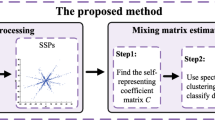Abstract
The number of sources in an underdetermined blind source separation (UBSS) is more than the observed mixed signals. The UBSS involves two stages. In the first stage, the mixing matrix is estimated, and in the second, the source separation is performd. Researchers have proposed a number of methods based on clustering, time-frequency, and sparse component analysis to address UBSS. The performance in source separation as well as the estimated mixing matrix coefficients utilising older methods differed from the actual mixing matrix. In this approach, source signals are recovered by using the series of least square problem which is known as modified sparse component analysis. The suggested method estimates the mixing matrix by considering the one dimensional subspace, associated with time-frequency points of mixtures combined with hierarchical clustering. The one dimensional subspace is considered only for active source in which more energy exists compared to other sources in the mixing matrix estimation process. The proposed method’s performance is contrasted with that of approaches created using single source points. According on experimental findings, the suggested methodology performs better than other common approaches.
Access this chapter
Tax calculation will be finalised at checkout
Purchases are for personal use only
Similar content being viewed by others
References
Comon, P., Jutten, C.: Handbook of Blind Source Separation: Independent component analysis and applications. Academic press (2010)
Yu, X., Hu, D., Xu, J.: Blind source separation: theory and applications. John Wiley & Sons (2013)
Belouchrani, A., Abed-Meraim, K., Cardoso, J.-F., Moulines, E.: A blind source separation technique using second-order statistics. IEEE Trans. Signal Process. 45(2), 434–444 (1997)
Malik, H., Iqbal, A., Joshi, P., Agrawal, S., Bakhsh, F.I. (eds.): SCI, vol. 916. Springer, Singapore (2021). https://doi.org/10.1007/978-981-15-7571-6
Naik, G.R., Wang, W. (eds.): SCT, Springer, Heidelberg (2014). https://doi.org/10.1007/978-3-642-55016-4
Mansour, A., AI-Falou,A.: Performance indices for real-world applications. In: European Signal Processing Conference, pp. 1-5 (2006)
Comon, P., Jutten, C., Herault, J.: Blind Separation of Sources, Part II: Problem Statement. Signal Process. 24(1), 11–20 (1991)
Anil Kumar, V., Rama Rao, C.h.V.: Unsupervised noise removal technique based on constrained NMF. IET Signal Process. 11(7), 788–795 (2017)
Wang, L., Reiss, J.D., Cavallaro, A.: Over-determined source separation and localization using distributed microphones. IEEE/ACM Trans. Audio Speech Lang. Process. 24(9), 1569–1584 (2016)
Joho, M., Mathis, H., Lambert, R.H.: Overdetermined blind source separation: Using more sensors than source signals in a noisy mixture. In: Proceedings of ICA, pp. 81-86 (2000)
Souden, M., Affes, S., Benesty, J.: A new approach to blind separation of two sources with three sensors. In: Proceedings of IEEE Vehicular Technology Conference, pp. 1-5 (2006)
Duarte, L., Ando, R.A., Attux, R. Deville, Y., Jutten, C.: Separation of sparse signals in overdetermined linear-quadratic mixtures. In: Latent Variable Analysis and Signal Separation, pp. 239-246 (2012)
Osterwise, C., Grant, S.L.: On over-determined frequency domain BSS. IEEE/ACM Trans. Audio Speech. Lang. Process. 22(5), 956–966 (2014)
Anil Kumar, V., Rama Rao, C.h.V., Anirban, D.: Performance analysis of blind source separation using canonical correlation. Circ. Syst. Signal Process. 37(2), 658–673 (2018)
Anil Kumar, V., Rama Rao, C.h.V., Anirban, D.: Blind speech separation using canonical correlation and performance analysis. In: 2nd International Conference on Communication Systems, Computing and IT Applications (CSCITA), pp. 37-41 (2017)
Jourjine, A., Rickard, S., Yilmaz, O.: Blind separation of disjoint orthogonal signals: Demixing N sources from 2 mixtures. In: Proceedings of IEEE International Conference on Acoustics, Speech, and Signal Processing, vol. 5, pp. 2985-2988 (2000)
Bofill, P., Zibulevsky, M.: Underdetermined blind source separation using sparse representations’. Signal Process. 81(11), 2353–2362 (2001)
Georgiev, P., Theis, F., Cichocki, A.: Sparse component analysis and blind source separation of underdetermined mixtures. IEEE Trans. Neural Netw. 16(4), 992–996 (2005)
Abrard, F., Deville, Y.: A time-frequency blind signal separation method applicable to underdetermined mixtures of dependent sources. Signal Process. 85(7), 1389–1403 (2005)
Li, Y., Amari, S.-I., Cichocki, A., Ho, D., W.C., Xie, S.: Underdetermined blind source separation based on sparse representation. IEEE Trans. Signal Process. 54(2), 423-437 (2006)
Luo, Y., Wang, W., Chambers, J.A., Lambotharan, S., Proudler, I.: Exploitation of source nonstationarity in underdetermined blind source separation with advanced clustering techniques. IEEE Trans. Signal Process. 54(6), 2198–2212 (2006)
Reju, V.G., Koh, S.N., Soon, I.Y.: An algorithm for mixing matrix estimation in instantaneous blind source separation. Signal Process. 89(9), 1762–1773 (2009)
Peng, D., Xiang, Y.: Underdetermined blind separation of nonsparse sources using spatial time-frequency distributions. Digit. Signal Process. 20(2), 581–596 (2010)
Guo, Q., Ruan, G., Nan, P.: Underdetermined mixing matrix estimation algorithm based on single source points. Circ. Syst. Signal Process. 1–15 (2017)
Linh Trung, N., Belouchrani, A., Abed-Meraim, K., Boashash, B.: Separating more sources than sensors using time-frequency distributions. EURASIP J. Appl. Signal Process. 2828–2847 (2005)
Belouchrani, A., Amin, M.G.: Blind source separation based on time-frequency signal representations. IEEE Trans. Signal Process. 46(11), 2888–2897 (1998)
Aissa-El-Bey, A., Linh-Trung, N., Abed-Meraim, K., Belouchrani, A., Grenier, Y.: Underdetermined blind separation of nondisjoint sources in the time-frequency domain. IEEE Trans. Signal Process. 55(3), 897–907 (2007)
Dong, T., Lei, Y., Yang, J.: An algorithm for underdetermined mixing matrix estimation. Neurocomputing 104, 26–34 (2013)
Zhang, M., Yu, S., Wei, G.: Sequential blind identification of underdetermined mixtures using a novel deflation scheme. IEEE Trans. Neural Netw. Learn. Syst. 24(9), 1503–1509 (2013)
Zhen, L., Peng, D., Yi, Z., Xiang, Y., Chen, P.: Underdetermined blind source separation using sparse coding. IEEE Transac. Neural Netw. Learn. Syst. 28(12), 3102–3108 (2017)
Fadaili, E.M., Moreau, N.T., Moreau, E.: Nonorthogonal joint diagonalization/zero diagonalization for source separation based on time-frequency distributions. IEEE Trans. Signal Process. 55(5), 1673–1687 (2007)
Donoho, D.L.: For most large underdetermined systems of linear equations the minimal \(\ell _{1}\)-norm solution is also the sparsest solution. Commun. Pure Appl. Math. 59(6), 797–829 (2006)
Asif, M.S., Romberg, J.: Sparse recovery of streaming signals using \(\ell _{1}\)-homotopy. IEEE Trans. Signal Process. 62(6), 4209–4223 (2014)
Peng, X., Yi, Z., Tang, H.: Robust subspace clustering via thresholding ridge regression. In: AAAI Conference on Artificial Intelligence (AAAI), pp. 3827–3833 (2015)
Peng, X., Tang, H., Zhang, L., Yi, Z., Xiao, S.: A unified framework for representation-based subspace clustering of out-of-sample and large-scale data. IEEE Trans. Neural Netw. Learn. Syst. 27(12), 2499–2512 (2016)
Vincent, E., Gribonval, R., Févotte, C.: Performance measurement in blind audio source separation. IEEE Trans. Audio Speech Lang. Process. 14(4), 1462–1469 (2006)
Author information
Authors and Affiliations
Corresponding author
Editor information
Editors and Affiliations
Rights and permissions
Copyright information
© 2023 The Author(s), under exclusive license to Springer Nature Switzerland AG
About this paper
Cite this paper
Vaghmare, A.K. (2023). BSS in Underdetermined Applications Using Modified Sparse Component Analysis. In: Sharma, H., Saha, A.K., Prasad, M. (eds) Proceedings of International Conference on Intelligent Vision and Computing (ICIVC 2022). ICIVC 2022. Proceedings in Adaptation, Learning and Optimization, vol 17. Springer, Cham. https://doi.org/10.1007/978-3-031-31164-2_31
Download citation
DOI: https://doi.org/10.1007/978-3-031-31164-2_31
Published:
Publisher Name: Springer, Cham
Print ISBN: 978-3-031-31163-5
Online ISBN: 978-3-031-31164-2
eBook Packages: Intelligent Technologies and RoboticsIntelligent Technologies and Robotics (R0)




